Healthy rivers are connected to their floodplain because floodplain flooding promotes nutrient cycling; creates a much more complex stream environment; helps to maintain adequate flows and cool water temperatures during the hot, dry summer months; and helps keep the channel stable. What's more, when a river is connected to its floodplain, the force of floodwaters is reduced, as are peak flows during floods. But over the past 100 years on the Jocko River, we have built levees, berms, dikes, and transportation corridors. In places we have channelized the river. The result has been a less stable, less complex, less resilient—and during floods, more dangerous—river. Explore the importance of keeping a river connected to its floodplain by clicking through the slides using the slide-navigation buttons () below.
Connected to the Floodplain: More Stable and Cooler Flows
Spring High Water
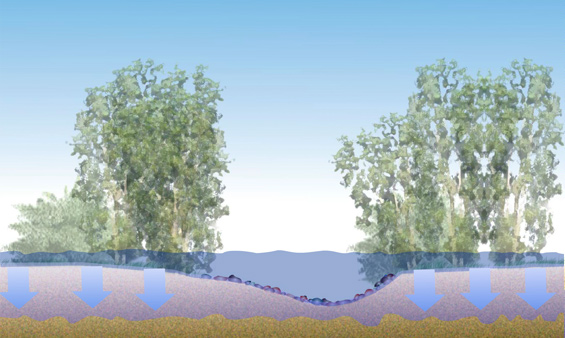
In spring, the floodplain soaks up flood waters.
Summer and Fall
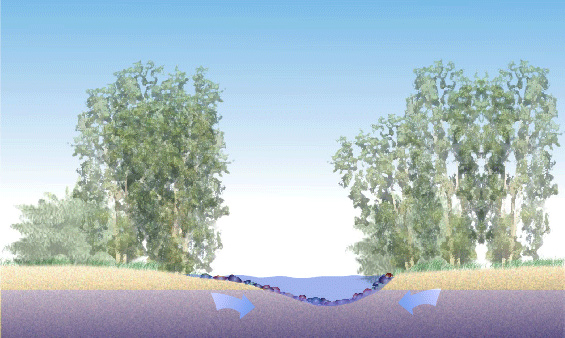
In the summer and fall, the floodplain slowly releases stored
floodwaters back to the stream.
Each spring, snows melt and stream flows rise. Often that water flows onto the floodplain where much of it is soaked up like a sponge.
Later in the year, in summer and fall when flows in the stream channel are low and warmer, that stored water slowly flows back into the channel, providing clean, cold water when it is most needed by people, fish, and other organisms.
Returning groundwater can moderate stream temperatures enough to make the stream habitable for many cold water species.
Not Connected: Less Stable and Warmer, Lower Flows
Spring High Water
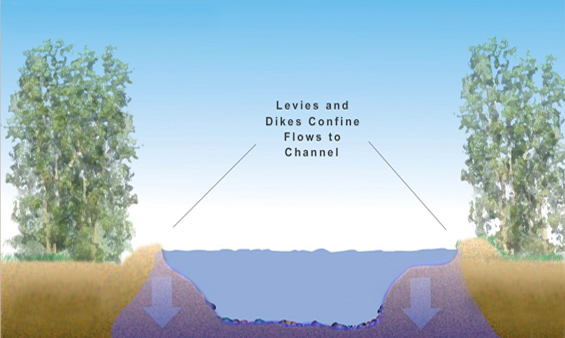
In spring, the floodplain has no access to floodwaters and so stays mostly dry.
Summer and Fall
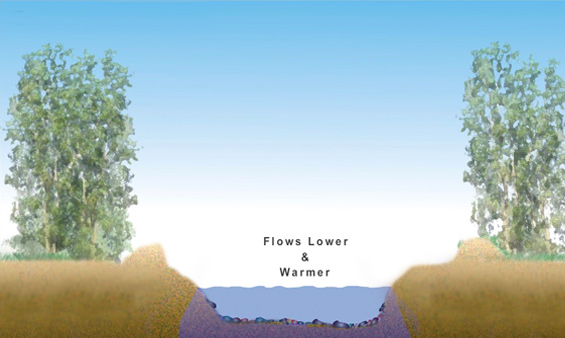
In the summer and fall, the floodplain has little or now water to release back to the stream.
In a stream confined by dikes and levies or otherwise channelized, the high flows in the spring don't reach the floodplain. As a consequence, the floodplain does not get recharged with water. Then later in the summer, the floodplain has nothing to return to the river. The consequences are serious:
• Lower stream flows in the summer and fall, a critical time for fish and aquatic insects.
• Warmer water temperatures because the floodplain is not returning cool groundwater to the stream. Bull trout and other aquatic species need cold water.
Connected to the Floodplain: More Stable Channel, More Complex Stream
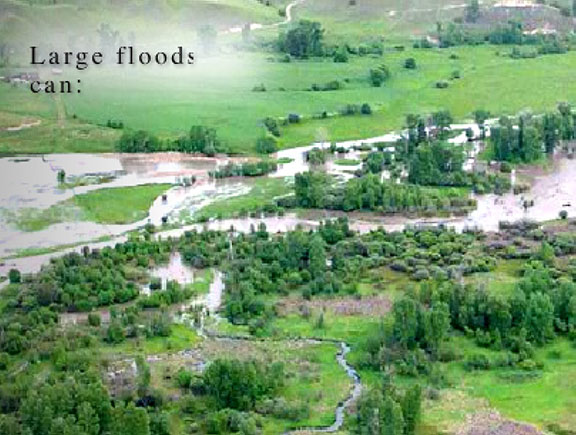
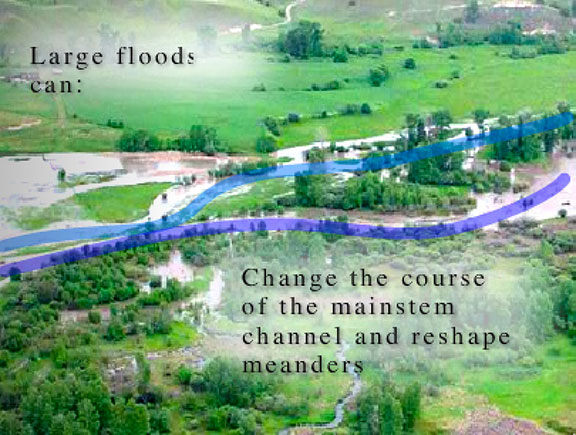
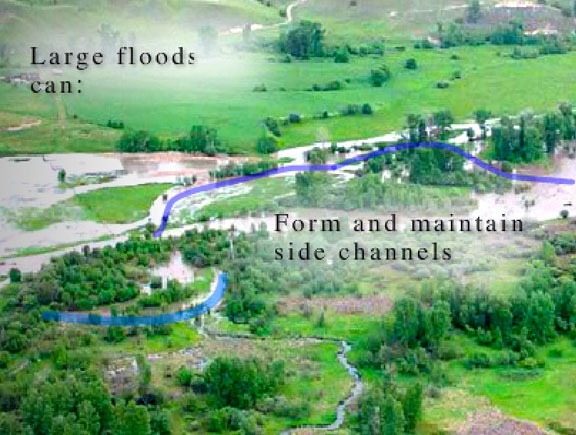
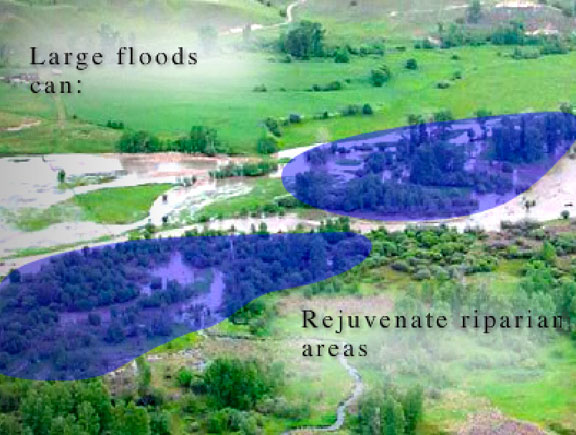
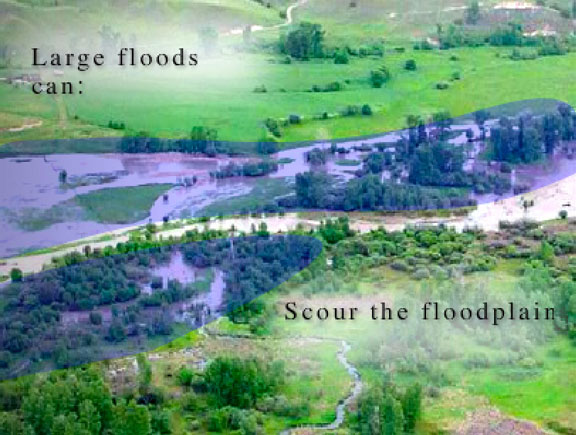
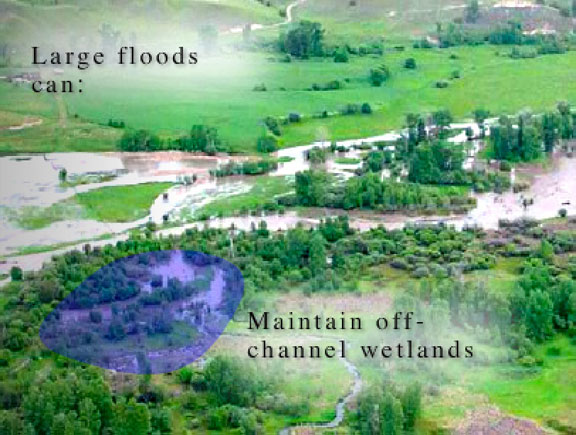
When a river is connected to its floodplain, high flows in the spring spread out over the floodplain and the water slows. Consequently, there is less channel erosion than if the stream is confined and focuses all of its power and erosive energy on bank margins.
Rivers that are connected to the flood-plain are also more complex, which is better for fish and wildlife. That's be-cause as a river overflows its banks and expands onto the floodplain, it rejuven-ates riparian stands, forms and maintains side channels, scours floodplains, develops and rearranges point bars, and maintains off channel wetlands.
Not Connected: Less Stable Channel, Less Complex Stream



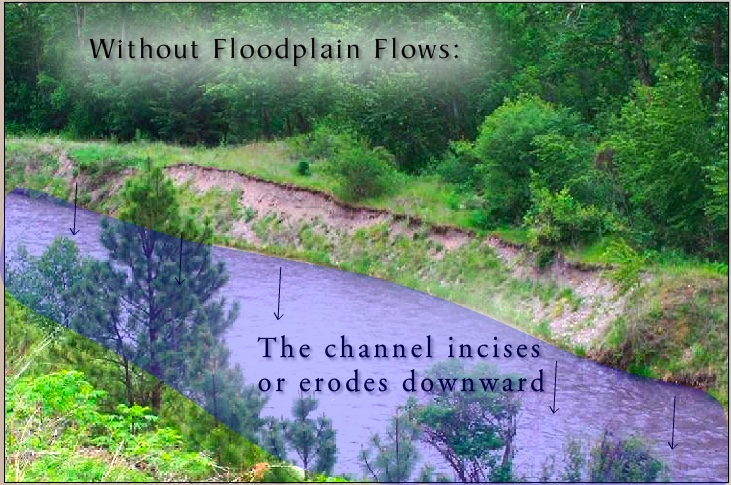
The photo at left shows a section of the river that has been channelized and forced against the hillslopes along the National Bison Range. Here, the river no longer has access to its floodplain and has formed a very simplified channel.
A common result of diking, levees, and channelization is a reduction in the stream channel's length and a corres-ponding increase in the steepness or gradient of the channel. This focuses the stream's energy and causes it to down-cut, which leads to channel incision (the process by which a stream erodes its bed downward below the surrounding ground), which causes further isolation from the floodplain.
Connected to the Floodplain: More Nutrient Cycling, More Productive Floodplains
Click the image to see how floodplain flooding promotes nutrient cycling. When flood waters retreat they leave behind fresh deposits of sands and silts full of nutrients and carbon that promote the growth of riparian vegetation.
Floodplain flows are a natural phenomenon that cycles water, nutrients, and sediment through river systems. They scour away organic materials that accumulate on river bottoms and deposit sediment onto stream banks, encouraging growth of riparian vegetation.
Wetting of floodplain soil releases an immediate flush of nutrients: those left over from the last flood, and those that result from the rapid decomposition of organic matter that has ac-cumulated since then. Microscopic organisms thrive and larger species enter a rapid breeding cycle. Opportunistic feeders like birds move in to take advantage. The surge of new growth endures for some time, which makes floodplains particularly valuable for fish and wildlife.
Floodplain habitats provide some of the most important wildlife habitat in the Northern Rockies. For example, they support the highest diversity of breeding birds of any habitats in the western US. But when a floodplain is disconnected from its river, high spring flows are no longer able to spread across it, depositing a layer of nutrient-rich sediments. The floodplain becomes much less productive, which means it is much less valuable to wildlife. Bottom line: disconnecting a river from its floodplain degrades the most important wildlife habitats we have. When we protect riparian habitats, we protect fish and wildlife.
Without a Connection to the Floodplain, There is Often Greater Flood Damage
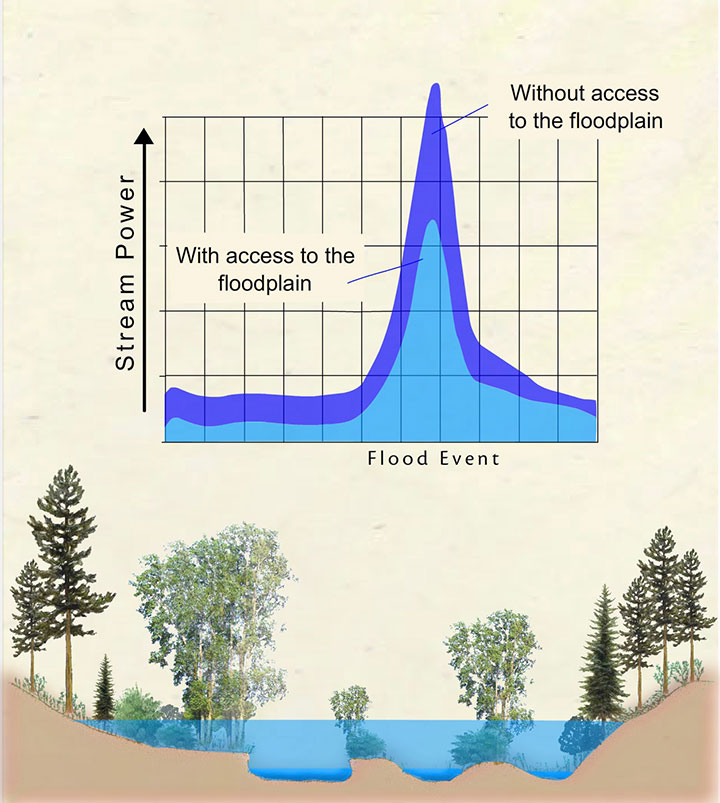
Riparian areas provide a variety of important habitats for trout. Perhaps most important, they contribute large woody debris (logs) to the stream, which provides resting, hiding, and feeding areas for native fish. Tree roots of both standing and downed trees also provide important cover for juvenile trout.
In addition, riparian areas provide important habitat for birds and mammals. Three quarters of species in Montana use riparian habitats.
The removal of trees from riparian areas eliminates the source of large woody debris, which is essential to maintaining habitat complexity and productivity.
Grazing and trampling of vegetation by livestock can also damage habitats for fish and wildlife. The result is often wide, open channels with lower, warmer, and more turbid flows in summer; damaging ice conditions in winter; and flashier, more turbid flows during high-water periods in spring.
Healthy rivers are connected to their floodplain because floodplain flooding promotes nutrient cycling; creates a much more complex stream environment; helps to maintain adequate flows and cool water temperatures during the hot, dry summer months; and helps keep the channel stable. What's more, when a river is connected to its floodplain, the force of floodwaters is reduced, as are peak flows during floods. But over the past 100 years on the Jocko River, we have built levees, berms, dikes, and transportation corridors. In places we have channelized the river. The result has been a less stable, less complex, less resilient—and during floods, more dangerous—river. Explore the importance of keeping a river connected to its floodplain by clicking through the slides using the slide-navigation buttons () below.
Connected to the Floodplain: More Stable and Cooler Flows
Spring High Water
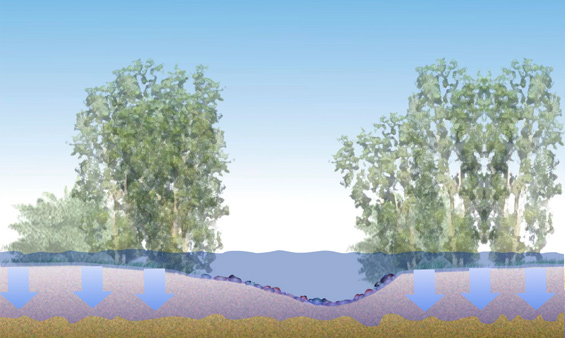
In spring, the floodplain soaks up flood waters.
Summer and Fall
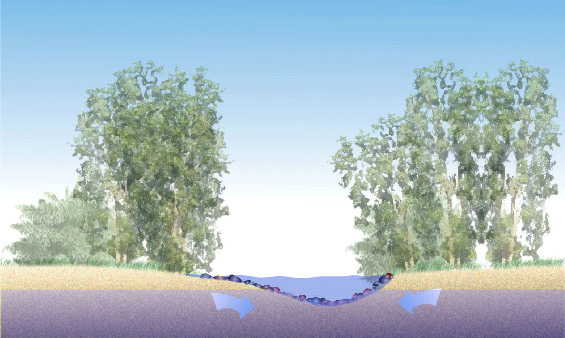
In the summer and fall, the floodplain slowly releases stored
floodwaters back to the stream.
Each spring, snows melt and stream flows rise. Often that water flows onto the floodplain where much of it is soaked up like a sponge.
Later in the year, in summer and fall when flows in the stream channel are low and warmer, that stored water slowly flows back into the channel, providing clean, cold water when it is most needed by people, fish, and other organisms.
Returning groundwater can moderate stream temperatures enough to make the stream habitable for many cold water species.
Not Connected: Less Stable and Warmer, Lower Flows
Spring High Water

In spring, the floodplain has no access to floodwaters and so stays mostly dry.
Summer and Fall

In the summer and fall, the floodplain has little or now water to release back to the stream.
In a stream confined by dikes and levies or otherwise channelized, the high flows in the spring don't reach the floodplain. As a consequence, the floodplain does not get recharged with water. Then later in the summer, the floodplain has nothing to return to the river. The consequences are serious:
• Lower stream flows in the summer and fall, a critical time for fish and aquatic insects.
• Warmer water temperatures because the floodplain is not returning cool groundwater to the stream. Bull trout and other aquatic species need cold water.
Connected to the Floodplain: More Stable Channel, More Complex Stream
When a river is connected to its floodplain, high flows in the spring spread out over the floodplain and the water slows. Consequently, there is less channel erosion than if the stream is confined and focuses all of its power and erosive energy on bank margins.
Rivers that are connected to the flood-plain are also more complex, which is better for fish and wildlife. That's be-cause as a river overflows its banks and expands onto the floodplain, it rejuven-ates riparian stands, forms and maintains side channels, scours floodplains, develops and rearranges point bars, and maintains off channel wetlands.
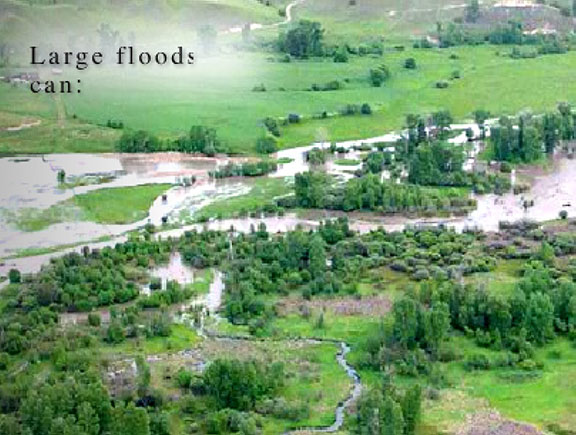
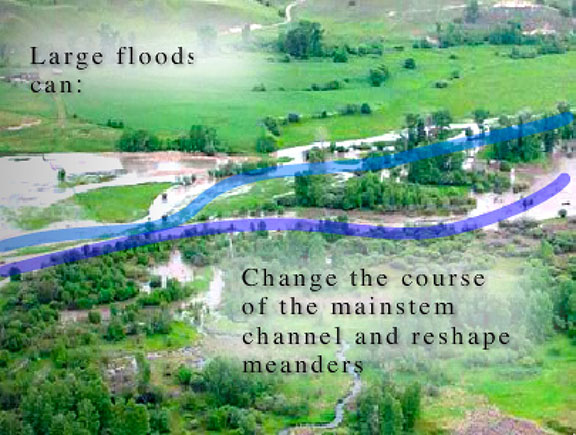
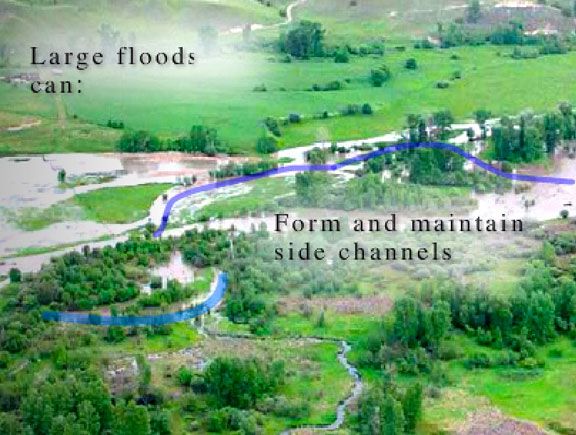
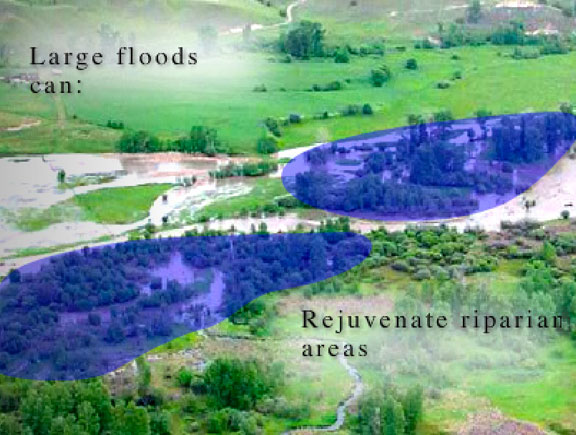
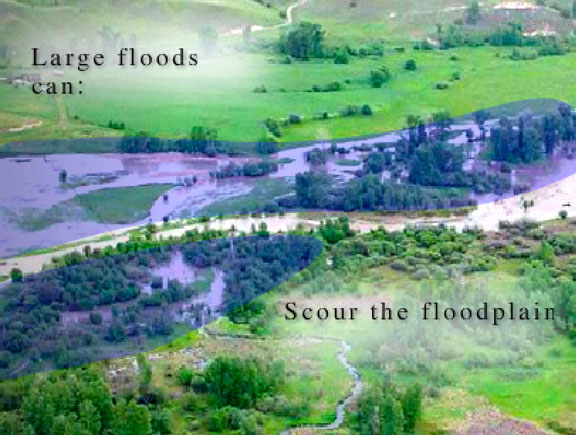
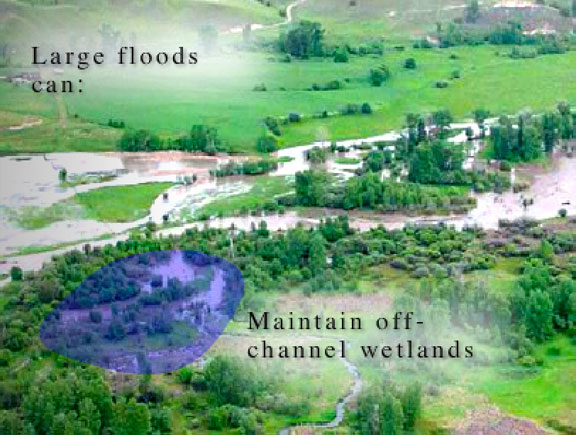
Not Connected: Less Stable Channel, Less Complex Stream
The photo at left shows a section of the river that has been channelized and forced against the hillslopes along the National Bison Range. Here, the river no longer has access to its floodplain and has formed a very simplified channel.
A common result of diking, levees, and channelization is a reduction in the stream channel's length and a corres-ponding increase in the steepness or gradient of the channel. This focuses the stream's energy and causes it to down-cut, which leads to channel incision (the process by which a stream erodes its bed downward below the surrounding ground), which causes further isolation from the floodplain.
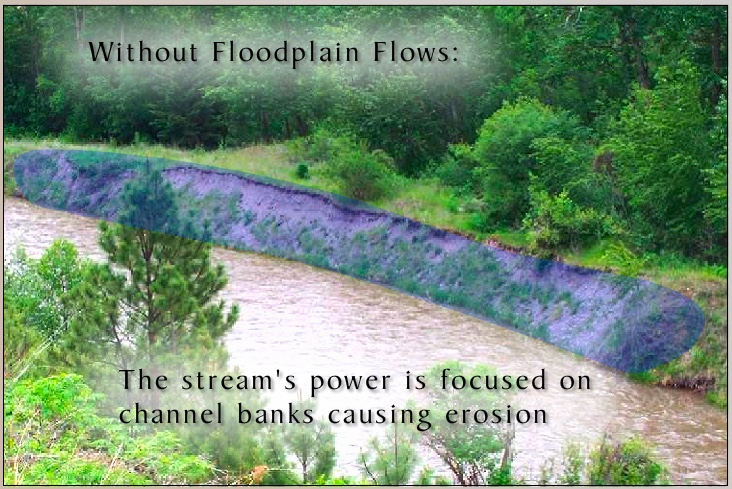
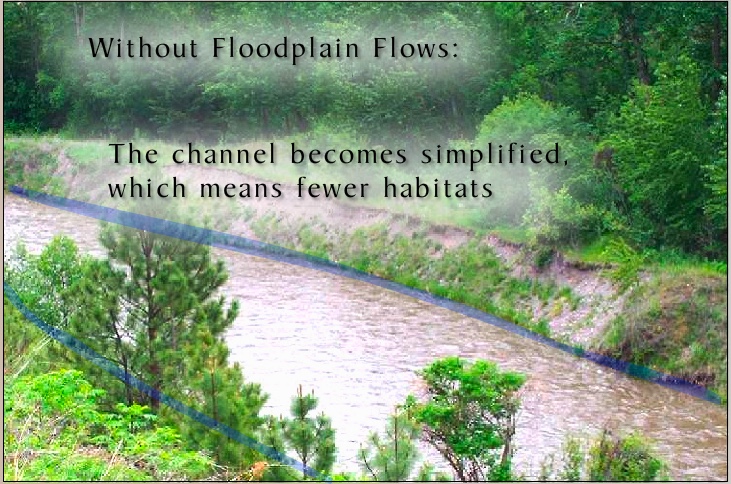

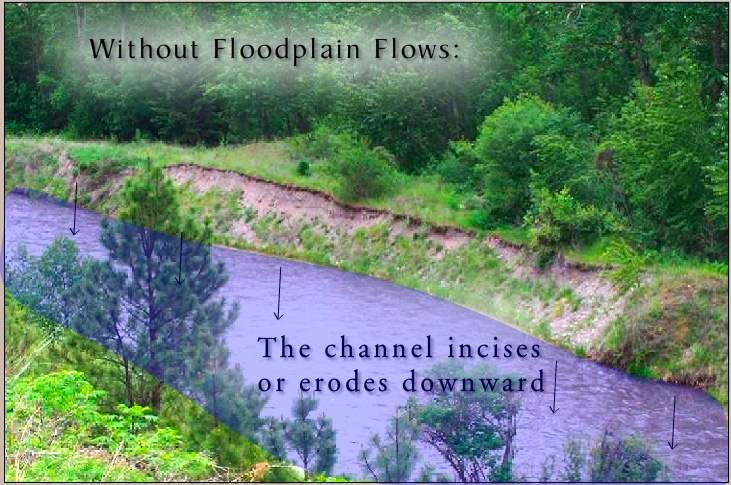
Connected to the Floodplain: More Nutrient Cycling, More Productive Floodplains
Click the image to see how floodplain flooding promotes nutrient cycling. When flood waters retreat they leave behind fresh deposits of sands and silts full of nutrients and carbon that promote the growth of riparian vegetation.
Floodplain flows are a natural phenomenon that cycles water, nutrients, and sediment through river systems. They scour away organic materials that accumulate on river bottoms and deposit sediment onto stream banks, encouraging growth of riparian vegetation.
Wetting of floodplain soil releases an immediate flush of nutrients: those left over from the last flood, and those that result from the rapid decomposition of organic matter that has ac-cumulated since then. Microscopic organisms thrive and larger species enter a rapid breeding cycle. Opportunistic feeders like birds move in to take advantage. The surge of new growth endures for some time, which makes floodplains particularly valuable for fish and wildlife.
Floodplain habitats provide some of the most important wildlife habitat in the Northern Rockies. For example, they support the highest diversity of breeding birds of any habitats in the western US. But when a floodplain is disconnected from its river, high spring flows are no longer able to spread across it, depositing a layer of nutrient-rich sediments. The floodplain becomes much less productive, which means it is much less valuable to wildlife. Bottom line: disconnecting a river from its floodplain degrades the most important wildlife habitats we have. When we protect riparian habitats, we protect fish and wildlife.
Without a Connection to the Floodplain, There is Often Greater Flood Damage

Riparian areas provide a variety of important habitats for trout. Perhaps most important, they contribute large woody debris (logs) to the stream, which provides resting, hiding, and feeding areas for native fish. Tree roots of both standing and downed trees also provide important cover for juvenile trout.
In addition, riparian areas provide important habitat for birds and mammals. Three quarters of species in Montana use riparian habitats.
The removal of trees from riparian areas eliminates the source of large woody debris, which is essential to maintaining habitat complexity and productivity.
Grazing and trampling of vegetation by livestock can also damage habitats for fish and wildlife. The result is often wide, open channels with lower, warmer, and more turbid flows in summer; damaging ice conditions in winter; and flashier, more turbid flows during high-water periods in spring.
Healthy rivers are connected to their floodplain because floodplain flooding promotes nutrient cycling; creates a much more complex stream environment; helps to maintain adequate flows and cool water temperatures during the hot, dry summer months; and helps keep the channel stable. What's more, when a river is connected to its floodplain, the force of floodwaters is reduced, as are peak flows during floods. But over the past 100 years on the Jocko River, we have built levees, berms, dikes, and transportation corridors. In places we have channelized the river. The result has been a less stable, less complex, less resilient—and during floods, more dangerous—river. Explore the importance of keeping a river connected to its floodplain by clicking through the slides using the slide-navigation buttons () below.
Connected to the Floodplain: More Stable and Cooler Flows
Spring High Water
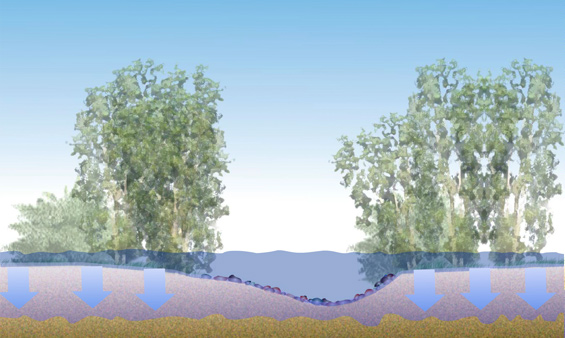
In spring, the floodplain soaks up flood waters.
Summer and Fall
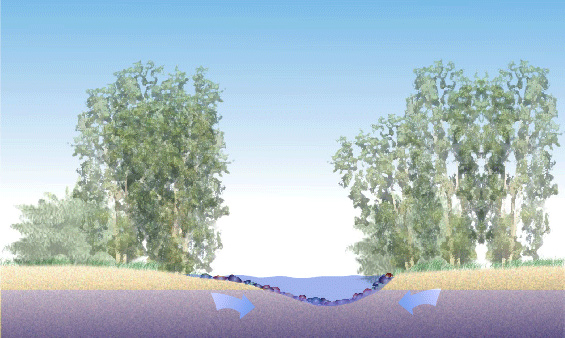
In the summer and fall, the floodplain slowly releases stored
floodwaters back to the stream.
Each spring, snows melt and stream flows rise. Often that water flows onto the floodplain where much of it is soaked up like a sponge.
Later in the year, in summer and fall when flows in the stream channel are low and warmer, that stored water slowly flows back into the channel, providing clean, cold water when it is most needed by people, fish, and other organisms.
Returning groundwater can moderate stream temperatures enough to make the stream habitable for many cold water species.
Not Connected: Less Stable and Warmer, Lower Flows
Spring High Water
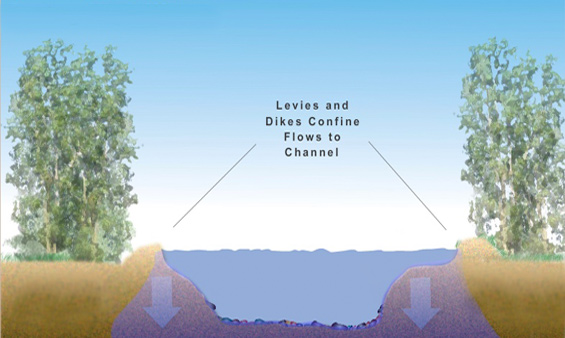
In spring, the floodplain has no access to floodwaters and so stays mostly dry.
Summer and Fall
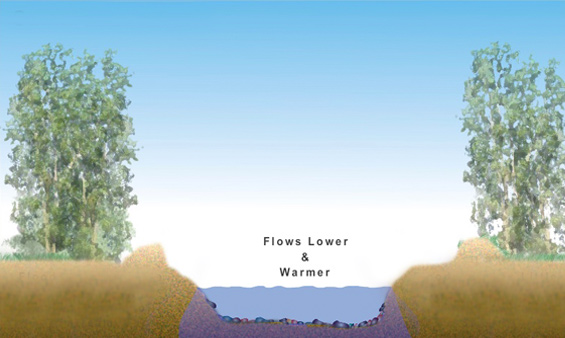
In the summer and fall, the floodplain has little or now water to release back to the stream.
In a stream confined by dikes and levies or otherwise channelized, the high flows in the spring don't reach the floodplain. As a consequence, the floodplain does not get recharged with water. Then later in the summer, the floodplain has nothing to return to the river. The consequences are serious:
• Lower stream flows in the summer and fall, a critical time for fish and aquatic insects.
• Warmer water temperatures because the floodplain is not returning cool groundwater to the stream. Bull trout and other aquatic species need cold water.
Connected to the Floodplain: More Stable Channel, More Complex Stream
When a river is connected to its floodplain, high flows in the spring spread out over the floodplain and the water slows. Consequently, there is less channel erosion than if the stream is confined and focuses all of its power and erosive energy on bank margins.
Rivers that are connected to the flood-plain are also more complex, which is better for fish and wildlife. That's be-cause as a river overflows its banks and expands onto the floodplain, it rejuven-ates riparian stands, forms and maintains side channels, scours floodplains, develops and rearranges point bars, and maintains off channel wetlands.

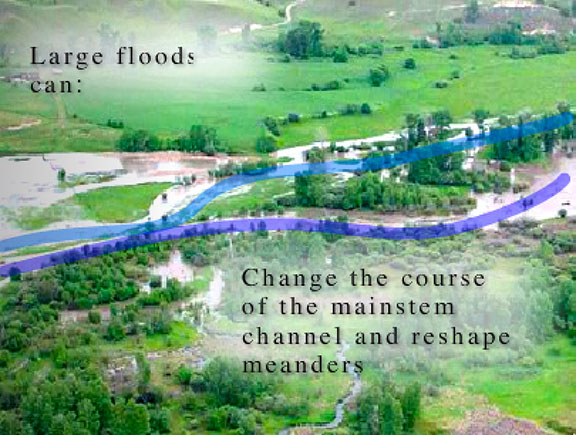

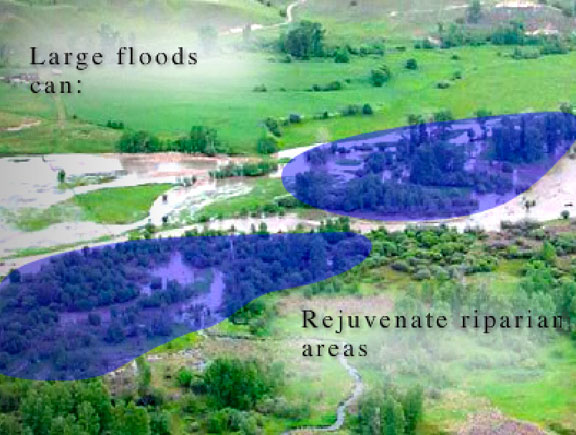
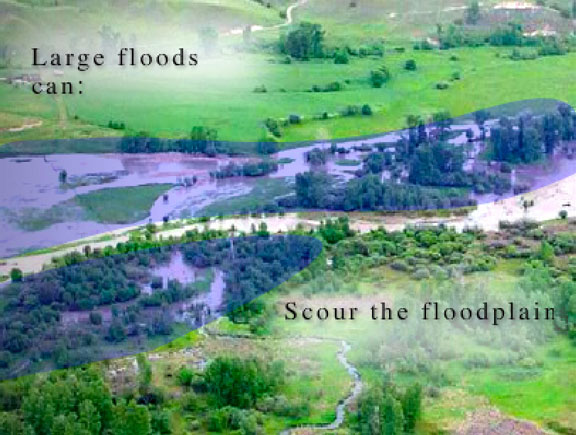
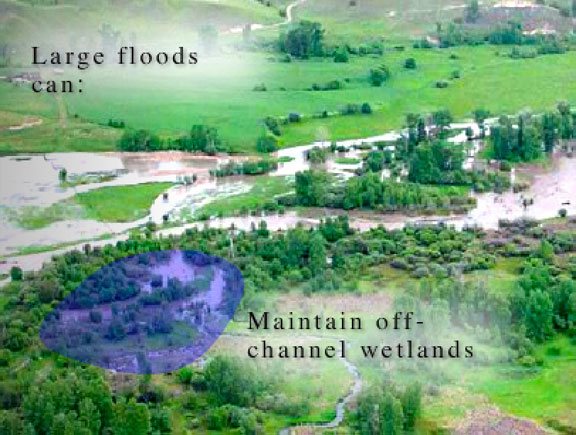
Not Connected: Less Stable Channel, Less Complex Stream
The photo at left shows a section of the river that has been channelized and forced against the hillslopes along the National Bison Range. Here, the river no longer has access to its floodplain and has formed a very simplified channel.
A common result of diking, levees, and channelization is a reduction in the stream channel's length and a corres-ponding increase in the steepness or gradient of the channel. This focuses the stream's energy and causes it to down-cut, which leads to channel incision (the process by which a stream erodes its bed downward below the surrounding ground), which causes further isolation from the floodplain.
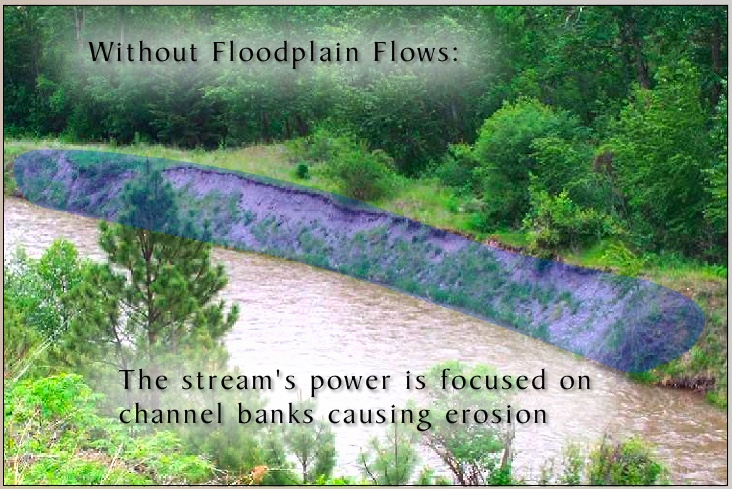


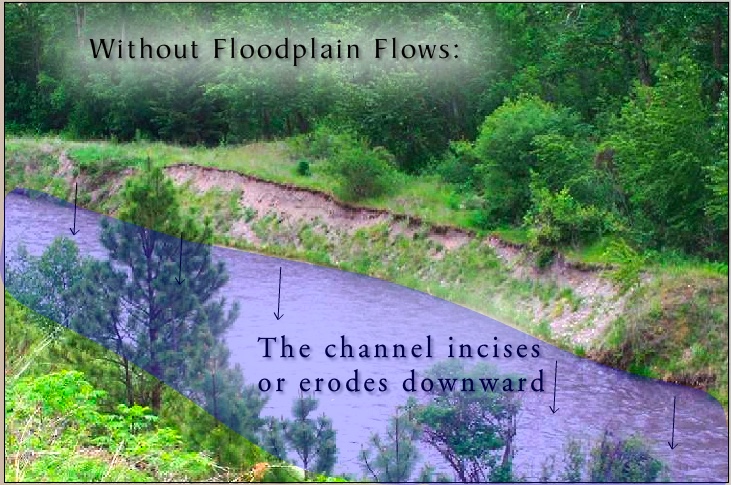
Connected to the Floodplain: More Nutrient Cycling, More Productive Floodplains
Click the image to see how floodplain flooding promotes nutrient cycling. When flood waters retreat they leave behind fresh deposits of sands and silts full of nutrients and carbon that promote the growth of riparian vegetation.
Floodplain flows are a natural phenomenon that cycles water, nutrients, and sediment through river systems. They scour away organic materials that accumulate on river bottoms and deposit sediment onto stream banks, encouraging growth of riparian vegetation.
Wetting of floodplain soil releases an immediate flush of nutrients: those left over from the last flood, and those that result from the rapid decomposition of organic matter that has ac-cumulated since then. Microscopic organisms thrive and larger species enter a rapid breeding cycle. Opportunistic feeders like birds move in to take advantage. The surge of new growth endures for some time, which makes floodplains particularly valuable for fish and wildlife.
Floodplain habitats provide some of the most important wildlife habitat in the Northern Rockies. For example, they support the highest diversity of breeding birds of any habitats in the western US. But when a floodplain is disconnected from its river, high spring flows are no longer able to spread across it, depositing a layer of nutrient-rich sediments. The floodplain becomes much less productive, which means it is much less valuable to wildlife. Bottom line: disconnecting a river from its floodplain degrades the most important wildlife habitats we have. When we protect riparian habitats, we protect fish and wildlife.
Without a Connection to the Floodplain, There is Often Greater Flood Damage

Riparian areas provide a variety of important habitats for trout. Perhaps most important, they contribute large woody debris (logs) to the stream, which provides resting, hiding, and feeding areas for native fish. Tree roots of both standing and downed trees also provide important cover for juvenile trout.
In addition, riparian areas provide important habitat for birds and mammals. Three quarters of species in Montana use riparian habitats.
The removal of trees from riparian areas eliminates the source of large woody debris, which is essential to maintaining habitat complexity and productivity.
Grazing and trampling of vegetation by livestock can also damage habitats for fish and wildlife. The result is often wide, open channels with lower, warmer, and more turbid flows in summer; damaging ice conditions in winter; and flashier, more turbid flows during high-water periods in spring.
© 2021 Confederated Salish and Kootenai Tribes | Contact Us
© 2021 Confederated Salish and Kootenai Tribes | Contact Us